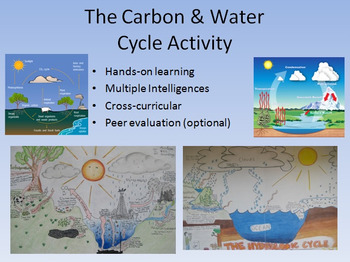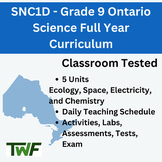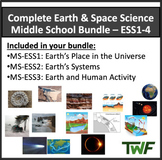Water and Carbon Cycle Diagram Activity - Bring out their creativity!
- Zip
Also included in
- This package includes the complete lesson set for an Ecology Unit on Sustainable Ecosystems. 5 weeks of teaching material includes assignments, worksheets, boom cards, exit tickets, Bill Nye video worksheets, unit tests, and a lab. Included in the Unit Package:- Office and Google versions of each lePrice $35.97Original Price $64.49Save $28.52
- This is my entire Grade 9 Science Ontario teaching curriculum. This is what I use to teach my grade 9 class in Ontario. It includes all four units - Ecology, Space, Chemistry, and Electricity. In addition, you'll find my Scientific Skills and Safety unit. Each unit will take approximately 3-5 weeksPrice $97.47Original Price $256.69Save $159.22
- Water Unit. This unit includes a full lesson set for complete coverage of water, Earth's hydrosphere, the water cycle, and water's role in weather along with associated activities. This resource is a collection of activities. There is no teaching timeline. However, it does include everything you wilPrice $19.97Original Price $147.57Save $127.60
- The Cycling of Matter: The Water and Carbon Cycles - A 5E Lesson Bundle for middle and high school students. Everything you need in one tidy package! This fully-editable, no prep bundle follows the 5E model and provides step-by-step instructions on how to implement it in your classroom. Each includePrice $14.97Original Price $29.18Save $14.21
- This Middle School Life Science Complete Bundle includes all the resources you need to teach Middle School Life science according to the NGSS. Your Bundle IncludesMS-LS1 From Molecules to Organisms: Structures and ProcessesMS-LS2 Ecosystems: Interactions, Energy, and DynamicsMS-LS3 Heredity: InheritPrice $87.47Original Price $248.97Save $161.50
- Each resource inside this bundle was handpicked to cover all aspects of the MS-LS2 NGSS (MS-LS2-1 to MS-LS2-5) curriculum. The resources found inside will ensure your students fulfill each requirement of the standard and keep them interested and engaged throughout. Your purchase also includes a breaPrice $29.97Original Price $60.54Save $30.57
- Each resource inside this bundle was handpicked to cover all aspects of the MS-ESS2 curriculum (ESS2-1, ESS2-2, ESS2-3, ESS2-4, ESS2-5, ESS2-6). The resources found inside will ensure your students fulfill each requirement of the standard and keep them interested and engaged throughout. Your purchasPrice $29.47Original Price $98.96Save $69.49
- This Middle School Earth and Space Science Complete Bundle includes all the resources you need to teach Middle School Earth and Space science according to the NGSS. Your Bundle IncludesMS-ESS1: Earth’s Place in the UniverseMS-ESS2: Earth’s SystemsMS-ESS3: Earth and Human ActivityYour purchase also iPrice $78.97Original Price $258.26Save $179.29
Description
This package is broken into a water cycle and a carbon cycle assignment. Usually, what I do is use the water cycle as a practice run (more formative assessment), then the carbon cycle as graded work but the tasks can be used however you like. Your students will use their varied learning styles to complete this assignment.
Those who love art will enjoy the chance to really get creative and design something fantastic. Others will enjoy the way the task is set out step-wise with easy to follow instructions. Both will create something they can be proud of and at the same time, they will be learning about the water and carbon cycle. Great for upper elementary, middle and high school classes. These activities can easily be adapted for lower elementary by simplifying some wording and reducing the task requirements.
**********************
If you'd like to save some money, this activity can also be found inside my Cycling of Matter: The Water and Carbon Cycles - Complete 5E Lesson Bundle. If you'd like to take a look, please CLICK HERE.
**********************
Included in the activity package is:
- A full overview of both tasks
- An itemized list of all required items
- The water cycle contains a graded checklist for the required components
- The carbon cycle contains two different rubrics depending on the depth you want to go into
- Exemplary student examples for both assignments
------------------------------------------
You might also be interested in the following activities as they relate directly to the cycling of matter.
• Cycling of Matter in Ecosystems – Device-Based Scavenger Hunt Activity
• Cycling of Matter in Ecosystems Lesson - PowerPoint Lesson and Activity Package
• The Carbon and Water Cycle - 7 Engaging Lab Station Activities
• The Water Cycle - Science Reading Article - Grades 5-7
-----------------------------------------------------------------------------
Buyer Comments:
- "Great activity! Was a wonderful way to check for understanding and have them share their knowledge and creativity!"
- "This really helped anchor the abstract concepts for my concrete thinking students. "
- "We just finished drawings and they will be displayed! Great information and visual, thanks!"
- "Thanks. I used this last year and will use again in the future."
- "I loved this resource. Great idea to change it up and get the students involved. The rubric is very helpful!!"
- "Loved this. Thank you for providing real life examples. They were a real help to my students."
- "Great Resource!"
-"This activity is awesome. My students were able to really show their creativity while proving their content knowledge. "
NGSS:
MS-LS2-3 - Develop a model to describe the cycling of matter and flow of energy among living and nonliving parts of an ecosystem.
This standard focuses on modeling the cycling of matter (such as water and carbon) through ecosystems. The diagram activities in the resource have students model the water and carbon cycles.
MS-LS2-4 - Construct an argument supported by empirical evidence that changes to physical or biological components of an ecosystem affect populations.
By modeling the cycling of matter, students gain an understanding of how changes to parts of an ecosystem (like water or carbon availability) can impact populations within that ecosystem.
MS-ESS2-1 - Develop a model to describe the cycling of Earth's materials and the flow of energy that drives this process.
This broader standard encompasses modeling the cycling of matter like water and carbon at the global scale. The water and carbon cycle models connect to this bigger picture.
MS-ESS3-1 - Construct a scientific explanation based on evidence for how the uneven distributions of Earth's mineral, energy, and groundwater resources are the result of past and current geoscience processes.
The models can help explain the uneven distribution of water resources based on the water cycle processes.
This Product can also be found as part of my Ecology and Ecosystems Activities and Assessments Package where you will receive 9 ecology activities/assessments and save 50%.
**Please note that this activity can be found within the Ecosystems Unit. Click here to have a look.
The individual Ecology Lessons for the unit can be found below:
Lesson 1 - The Spheres of the Earth
Lesson 3 - Energy Flow In Ecosystems
Lesson 4 - Cycling of Matter In Ecosystems
Lesson 5 - Population Influences within Ecosystems
Lesson 6 - Ecological Succession
Lesson 7 - Biomass and Fossil Fuels
Lesson 8 - The Importance of Biodiversity
Buyer Comment: "I really liked these! My 7th grade advanced science students made some beautiful drawings that are still hanging in the hallway!"
I also have a range assignments and lessons/units from other grade levels at my store.Please CLICK HERE to have a look around and don’t forget to follow if you like what you see.
Also, please visit my blog Teach With Fergy for my thoughts on teaching, learning and everything in between.












